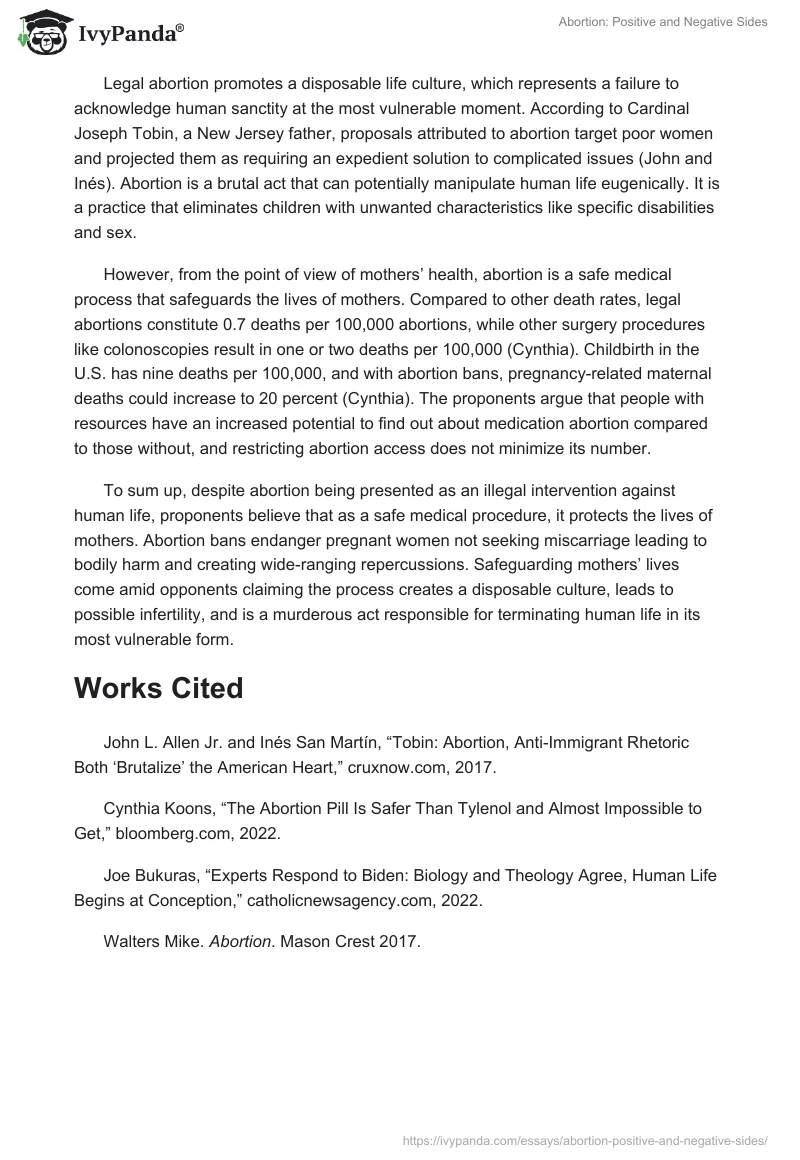Abortion is a common health intervention that is only safe when performed using World Health Organization (WHO) recommended methods appropriate to pregnancy duration. Further, the physician carrying out the practice must have the essential skills for the patient’s safety. WHO shows that in every ten pregnancies, six results in induced abortion, and an approximated 45 percent of conducted abortions are unsafe (John and Inés). In developing countries, the intervention rate is high, constituting 97 percent of the estimated abortions globally (WHO). The absence of affordable, timely, respectful, and safe access to abortion care has become a critical public health and human rights issue associated with annual 73 million induced abortions (WHO). Abortion creates a disposable culture, leads to possible infertility, and is a murderous act responsible for terminating human life at its most vulnerable form; however, it protects mothers’ lives.
Life starts at conception, where a sperm fertilizes an egg cell and begins the cell division process leading to the creation of a human. According to Tara Sander Lee, a Life Sciences Director and Senior Fellow at Charlotte Lozier Institute, the integrated approach that results in human creation is a biologically distinct process from other life forms (Bukura). The distinctiveness of the formed life constitutes its DNA, different from those of the biological parents. Abortion causes an end to this newly created being, which is murder in ethical and legal terms regardless of whether the life is only a few growing cells (Bukura). Even before the mother is aware of the being inside her, proceeding with the intervention is the termination of a human life, which people must respect. Since the fertilized egg cell is scientifically proven to be a being, abortion kills the living being making it murder.
Despite being performed with qualified practitioners, abortion results in possible infertility cases. Based on findings on women who have had abortions, Walters discovered that complications linked to the practice result in losing the ability to conceive in the future (53). Further, the relief feeling associated with the intervention dies shortly after and can potentially be a permanent sadness or guilt. From a psychological perspective, the sorrow and shame creep in almost immediately once the patient procures an abortion.
Legal abortion promotes a disposable life culture, which represents a failure to acknowledge human sanctity at the most vulnerable moment. According to Cardinal Joseph Tobin, a New Jersey father, proposals attributed to abortion target poor women and projected them as requiring an expedient solution to complicated issues (John and Inés). Abortion is a brutal act that can potentially manipulate human life eugenically. It is a practice that eliminates children with unwanted characteristics like specific disabilities and sex.
However, from the point of view of mothers’ health, abortion is a safe medical process that safeguards the lives of mothers. Compared to other death rates, legal abortions constitute 0.7 deaths per 100,000 abortions, while other surgery procedures like colonoscopies result in one or two deaths per 100,000 (Cynthia). Childbirth in the U.S. has nine deaths per 100,000, and with abortion bans, pregnancy-related maternal deaths could increase to 20 percent (Cynthia). The proponents argue that people with resources have an increased potential to find out about medication abortion compared to those without, and restricting abortion access does not minimize its number.
To sum up, despite abortion being presented as an illegal intervention against human life, proponents believe that as a safe medical procedure, it protects the lives of mothers. Abortion bans endanger pregnant women not seeking miscarriage leading to bodily harm and creating wide-ranging repercussions. Safeguarding mothers’ lives come amid opponents claiming the process creates a disposable culture, leads to possible infertility, and is a murderous act responsible for terminating human life in its most vulnerable form.
Works Cited
John L. Allen Jr. and Inés San Martín, “Tobin: Abortion, Anti-Immigrant Rhetoric Both ‘Brutalize’ the American Heart,” cruxnow.com, 2017.
Cynthia Koons, “The Abortion Pill Is Safer Than Tylenol and Almost Impossible to Get,” bloomberg.com, 2022.
Joe Bukuras, “Experts Respond to Biden: Biology and Theology Agree, Human Life Begins at Conception,” catholicnewsagency.com, 2022.
Walters Mike. Abortion. Mason Crest 2017.



